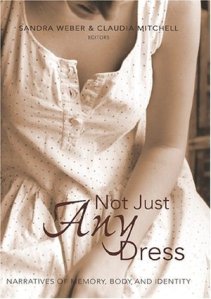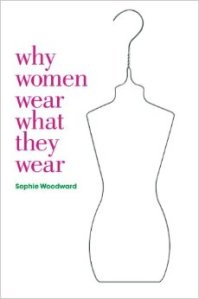So it was winter graduation. And there in the front row, three academic women. Floppy hats, robes of various colours. Tut tutting as the Jimmy Choos and Laboutins and various cheaper copies, all towering heels, went teetering past to audience applause. “I don’t know how they do it. Think of their feet in a few years time,” we said to each other, looking down at our warm waterproof winter boots, our sensible low heels.
After the event I discussed this Old Scold behaviour with Thesis Whisperer. Jokingly I noted that perhaps the need to make much of the shoe came from a bit of clerical eroticism – the flash of an ankle beneath the hem of monkly robes, a glance of a slender wrist emerging from the flowing sleeves… “It’s been done”, she said. “Oh” I said, “Of course.”
So to my holiday reading. True to my goal of not reading anything to do with my actual real research work, I have discovered Wardrobe Studies. Yes, it exists. Wardrobe Studies. And Dress Studies. And other literatures to do with clothes. It’s a whole new area to explore!!!
I have now bought:
And I now know that Sandra Weber has written the best thing about academic robes. The. Best. Thing. The best thing for me right now that is. Here’s a taster. With a rudeness warning, as some possibly lewd images are invoked, depending on your imagination.
I never know what to wear under the robe (at the University of X, there are strict rules about what to wear underneath, but that is unusual.) Should I wear dark pants as I usually do, like the men do, seeking to blend in, first and foremost as a scholar, showing that women can wear the pants as well as the robes of the Academy? Or, should I stress and celebrate my womanhood, standing out from the sea of male scholars by wearing what they can’t (although perhaps a few them secretly would like to) – things like nylons, high heels, silky underwear and a skirt or dress? Should I dress all in black, my habitual choice, so that it is the Academic Robe that is featured? Or, for once, should I wear something silver or gold or bright red that distracts from the gown and features my fondness for fashion eccentricity?
Oh, what does it matter anyway? Whatever I choose is mostly hidden by the bulk of the robe. And so is my body, for that matter, something I am increasingly grateful for as the pounds slip on and the flesh sags and bulges in ways I had not anticipated when younger. Yes, to be honest, I sometimes find myself quite content to hide beneath the gown. And, I hate to admit this, but I think my gown is rather nice. It has beautiful wide blue velvet stripes on the puffy sleeves and blue velvet borders on the front vertical edges. I unobtrusively stroke the soft velvet while seated on the stage, a way to calm and distract myself, I suppose.
Robed nudity is not an option that ever occurs to me, well, at least it didn’t until writing this piece. It can get so hot up under those stage-lights, that little or no clothes underneath might be a sensible choice if the darned robes weren’t so scratchy and flappy. But of course, in Western culture, nudity would not be read as a practical decision, would it? but rather as… as what? An erotic or exhibitionist act? A political stance? A way of privately subverting or mocking the whole meaning of the ceremony? A thumbing not of one’s nose but of one’s privates at the Academy? Perhaps there are some who entertain romantic or erotic notions of the naked academic (male or female) coyly reposing half robed on the leather couch in a twilight wood-panelled office, perhaps with a fire glowing in the stone hearth that seems requisite to such fantasies but so absent in the modern serviceability of our real university digs. (Weber, 2004,p. 101)
And so it goes on. It’s a giggle, and thought provoking at the same time. Just the kind of distraction we should all be reading over the break. Something that’s academic, of course, nothing frivolous, but not academic as we know it. Well, not as we usually read.
I’m not suggesting you need to read this book, of course, just a book that is not what you’d normally allow the time for. Something that brings a laugh, a sideways idea, a new perspective.
Why not? Go on, you know you can.
Happy reading to you all. I hope your choices are/were as much fun as mine.
Reference. Weber, S ( 2004) Curse you Descartes! My academic gown, in S. Weber and C Mitchell Eds. Not just any dress. Narratives of memory, body and identity. New York: Peter Lang. pp. 99-104












Great exclamation of recognition – my main concern is how to stop being choked to death by the hood, which men deftly anchor by putting the strap ( is it a strap?) under their tie, or buttoning the loop it comes with to their shirt. A dress has no such equipment! Another example of patriarchy in the academy, or just a design flaw?
LikeLike
Yep. Always a worry how to pin the hood to something.
LikeLike
A design flaw. Mediaeval monastic outfits, on which our robes are (very loosely) based, usually had an all in one hood, a bit like that on a modern anorak, or the duffel coat of my childhood. The hood was smaller, fixed in place, and intended, oddly enough, to keep the rain off 🙂
LikeLike